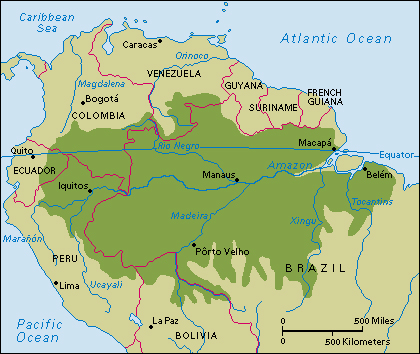A recent report released by the World Wildlife Fund (WWF) and the Brazilian Mamirauá Institute for Sustainable Development details 381 new animal and plant species discovered in the Amazon rain forest over a 24-month period. The report, titled “New Species of Vertebrates and Plants in the Amazon 2014-2015,” lists 216 new plants, 93 new fish, 32 new amphibians, 20 new mammals, 19 new reptiles, and 1 new bird in the vast Amazon region that spans several South American countries. The Amazon rain forest contains a wider variety of plant and animal life than any other place on Earth.
Among the new species of Amazon fish is the freshwater honeycomb stingray (Potamotrygon limai). Most stingrays live in shallow parts of the world’s oceans and in saltwater bays, but the honeycomb stingray lives in fresh water. The pattern on its back, or dorsal side, is usually dark brown with honeycomb-like speckles. The new mammals include a previously unknown species of pink river dolphin (Inia araguaiaensis). Analyses of skull bones of the new pink river dolphin show it to be different from other Amazon River dolphins and Bolivian river dolphins. Scientists believe the newly described dolphin parted from its Amazon basin cousins some 2.8 million years ago. There may be about 1,000 of these newly found pink river dolphins in the Amazon River system. The construction of hydroelectric dams and industrial, agricultural, and cattle ranching activities threaten the new pink river dolphin as well as many other forms of life.

Another new Amazon mammal is Milton’s titi monkey, known locally as the fire-tailed zogue zogue (Callicebus miltoni). Milton’s titi is known for its long, red-orange bushy tail and ocher sideburns and beards. The small primate weighs about 3 1/3 pounds (1.5 kilograms) and is named in honor of Milton Thiago de Mello, a noted Brazilian primatologist. The newly described monkey lives in southern parts of the Amazon region. Unfortunately, the small new titi population is threatened by deforestation.
This most recent WWF report is the third in a series that has listed some 2,000 new animal and plant species over the past 17 years. The report comes amid growing environmental disputes between mining interests and conservationists in Brazil, where a majority of the Amazon rain forest lies. Accelerated rates of habitat destruction in the region could push many of these new species to extinction before scientists have the chance to study them. The International Union for the Conservation of Nature (IUCN) has already labeled several of the newly identified plants and animals as threatened or endangered. In addition, the WWF is calling for urgent action to protect the Amazon rain forest itself. Aside from deforestation and pollution from agriculture, logging, and mining, a recent presidential decree in Brazil may eradicate an Amazonian nature reserve the size of Switzerland.
Untitled Document
Can't view the linked articles? Subscribe to World Book Online

World Book Online delivers a progressive sequence of core databases supported by supplemental
tools, such as language translation, graphic organizers, and unique Webquests. Moving from
Early World of Learning to World Book Advanced, World Book Online aligns end-users with their
appropriate learning levels. Each stand-alone site provides additional features to support the
needs of users’ specific capabilities.
The World Book Difference
World Book combines cutting-edge technology with traditional editorial excellence to produce
authoritative, trustworthy, and unbiased content. The digital content is updated in real time and
carefully curated for each learning level. Accessible 24/7, the content is available on a variety of devices.
World Book Online combines 21st-century instructional techniques with timely information.
By breaking down complex topics and using easily understandable text, World Book Online helps to
build fluency and increase comprehension. Featuring single sign-on capability, these sites are paired
with highly visual content to engage even the most reluctant reader. Our collection of resources kindles
a lifelong learning experience for every user. This adherence to clarity, currency, and accuracy makes
World Book’s digital offerings an information hub for the classroom, library, and beyond.
Image 1: Milton’s titi monkeys (Callicebus miltoni), also known as fire-tailed zogue zogues, are seen here in the jungles of the Mato Grasso in Brazil. The monkeys were among 381 new animal and plant species recently discovered in the Amazon rain forest. Credit: © Adriano Gambarini, Papéis Avulsos de Zoologia/SciELO
Image 2: The Amazon rain forest, the richest and most diverse ecosystem on Earth, covers much of northern South America. Credit: WORLD BOOK map